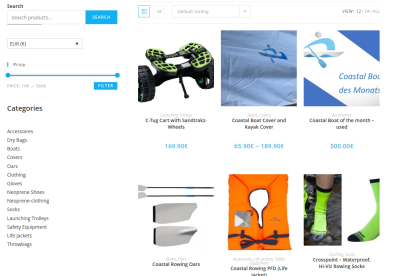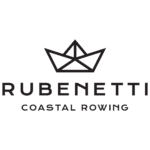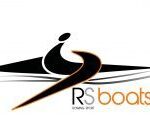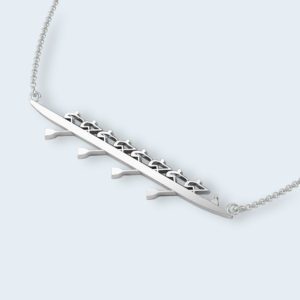Read Part 1 of this guest post from School Rowing New Zealand website sweep oar gearing
Rowing Gearing: how does it work?
Gearing a boat is all about all about balancing the load experienced by a rower with the efficiency of the oars and their arcs. Gearing is achieved by changing the leverage of the oars by changing the length of the oar and/or the inboard. The physics can be explained in this way:
- The less leverage there is the more resistance there is on the rower to transfer their power and the heavier the load feels (heavy gearing).
- The more leverage there is the easier it for the rower to transfer their power and the lighter the load feels (light gearing).
Heavy gearing transfers a lot of power for each stroke but places a big load on the rower: the heavier the load the greater the demand, the greater the demand the quicker the rower tires. The outcome is then usually more and more imperfections creeping into technique to maintain power as the rower tires.


With light gearing, the more leverage there is and less power will be transferred per stroke. However, the trade-off is the rower will not be under as much load and will not tire as quickly. Technique is maintained, form is held and rowers learn and hold their technique. These rowers can complete the race with skill, as against developing bad technique by trying to develop large amounts of power.
In the case of coaches for U15’s and U16’s they should be more concerned about teaching good technique and maintaining form throughout racing. Hence better boat speed is maintained at this level and fewer injuries are liable to occur while the rower goes through growth and muscle development. Although the physics related to light gearing may be less efficient it then becomes a matter of rating; rowers learn from the start that the racing rate of eights is 36-38 and not 32 or 34 and so on. Rowers also learn good co-ordination and hand movement when operating at this level.
One final factor in this equation is to consider the size of the blade. A big blade produces a lot of resistance so consequently requires a lot of explosive strength and, unless the rower is strong enough, will cause a long slow arc. The writer would tend to have a shorter blade arc to compensate which means the oar or scull will be shorter.
Rigging: what do I move?
This is the important bit, where theory is put into practice and coaches and crews can experiment to achieve the best outcome.
- Changing the spread (moving the pin) is the most important adjustment you’ll make. There are two reasons for this:
- the location of the pin has the most effect of any of the leverage dimensions; and
- changes to the pin affect all the other major rigging measurements.
The tighter the spread the heavier the gearing.
- Changing the oar length is the next most important adjustment in terms of leverage.
The longer the oar the heavier the gearing. - Changing the inboard is the next step, as this will adjust the length of time the blade is in the water.
The smaller the inboard the heavier the gearing.
However, there are some strange but important relationships between inboard and spread:
- When you adjust the inboard you make changes to the length of the outside arc, making it shorter or longer by small amounts.
- When you adjust the spread you are adjust the location of the outside arc making it closer or further away from the centre line.
Both these adjustments affect leverage. As far as the leverage is concerned there is a 3:1 ratio between the spread and the inboard. Moving the pin 1cm is the same as moving the collar 3cm. The thirty centimetre rule is also a critical rule to remember. It says the inboard should always be approximately 30cm longer than the spread.
What you may now have ascertained is: whenever an adjustment is made to the spread, inboard or oar length it has an impact on the location and lengths of both the inside and outside arcs.
- The length of the outside arc is critical as it directly affects the load on the rower and the efficiency of the rigger. Any changes to the spread or the oar length will change the length of the outside arc: the longer the arc the longer the stroke. The longer the stroke the further the boat moves each time the oar is moved. However we know the result is a greater load on the rower.
- The changes on the inside arc are mainly for rower comfort and the 30cm rule assists to ensure this comfort is maintained with efficiency.
Therefore, younger rowers should have a shorter arc, which means a shorter blade length. This may also mean that the area of the blade should be made smaller as well. For modern equipment management this seems to be the easiest way to suit everyone.
Read Part 1 Rigging for Rowing Oar gearing for Juniors








This Post Has One Comment
There is an App available for iPhone and android called Rigging for Rowing.